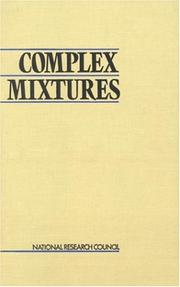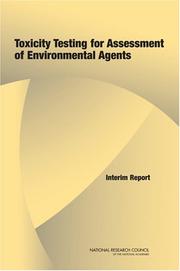| Listing 1 - 10 of 67 | << page >> |
Sort by
|
Book
ISBN: 9264070168 9789264070165 Year: 1998 Publisher: Paris : OECD Publishing,
Abstract | Keywords | Export | Availability | Bookmark
 Loading...
Loading...Choose an application
- Reference Manager
- EndNote
- RefWorks (Direct export to RefWorks)
This Test Guideline is a laboratory test method, designed to assess the oral acute toxicity of pesticides and other chemicals, to adult worker honeybees. Adult worker honeybees are exposed to five doses in a geometric series of the test substance dispersed in sucrose solution. A minimum of three replicate test groups, each of ten bees, should be dosed with each test concentration. A toxic standard (usually dimethoate) should be included in the test series. The bees are then fed the same diet, free of the test substance. The limit test corresponds to one dose level of 100 ìg active ingredient/bee. Mortality is recorded daily during at least 48 hours and compared with control values. If the mortality rate is increasing between 24 and 48h whilst control mortality remains at an accepted level it is appropriate to extend the duration of the test to a maximum of 96h. The study report should include the amount of diet consumed per group and the observation of all abnormal behavioural. The results are analysed in order to calculate the LD50 at 24h and 48h and, in case the study is prolonged, at 72h and 96h.
Environment --- Toxicity testing --- Poisons --- Toxicological testing --- Toxicology --- Toxicology testing --- Toxicology, Experimental --- Testing --- Toxicity testing.
Book
ISBN: 9789264070783 Year: 2018 Publisher: Paris : OECD Publishing,
Abstract | Keywords | Export | Availability | Bookmark
 Loading...
Loading...Choose an application
- Reference Manager
- EndNote
- RefWorks (Direct export to RefWorks)
This revised Test Guideline 412 (TG 412) has been designed to fully characterize test article toxicity by the inhalation route following repeated exposure for a limited period of time (28 days), and to provide data for quantitative inhalation risk assessments. It was updated in 2017 to enable the testing and characterisation of effects of nanomaterials tested. Groups of at least 5 male and 5 female rodents are exposed 6 hours per day for 28 days to a) the test chemical at three or more concentration levels, b) filtered air (negative control), and/or c) the vehicle (vehicle control). Animals are generally exposed 5 days per week but exposure for 7 days per week is also allowed. Males and females are always tested, but they may be exposed at different concentration levels if it is known that one sex is more susceptible to a given test article. This guideline allows the study director the flexibility to include satellite (reversibility) groups, bronchoalveolar lavage (BAL), lung burden (LB) for particles, neurologic tests, and additional clinical pathology and histopathological evaluations in order to better characterize the toxicity of a test chemical.
Toxicity testing --- Poisons --- Toxicological testing --- Toxicology --- Toxicology testing --- Toxicology, Experimental --- Testing --- Toxicity testing.
Book
ISBN: 9789264069992 Year: 1984 Publisher: Paris : OECD Publishing,
Abstract | Keywords | Export | Availability | Bookmark
 Loading...
Loading...Choose an application
- Reference Manager
- EndNote
- RefWorks (Direct export to RefWorks)
Suite à la décision du Conseil de l’OCDE, l’essai 204 "Poisson, Toxicité Prolongée: Étude sur 14 Jours" a été supprimé le 2 avril 2014.
Toxicity testing --- Poisons --- Toxicological testing --- Toxicology --- Toxicology testing --- Toxicology, Experimental --- Testing --- Toxicity testing.
Book
ISBN: 926418564X 9789264185647 Year: 2018 Publisher: Paris : OECD Publishing,
Abstract | Keywords | Export | Availability | Bookmark
 Loading...
Loading...Choose an application
- Reference Manager
- EndNote
- RefWorks (Direct export to RefWorks)
Cette Ligne directrice est élaborée en vue de permettre l’évaluation des effets pré- et postnataux d’une exposition aux produits chimiques, sur la reproduction et le développement, ainsi que l’examen de la toxicité systémique chez les femelles gravides et allaitantes ainsi que chez la descendance (petits et adultes). Dans cet essai, des groupes de rongeurs mâles et femelles sexuellement matures (génération parentale P) sont exposés en continu à une gradation de doses de la substance d’essai. L’exposition commence 2 semaines avant l’accouplement et se poursuit pendant la période d’accouplement, la gestation et jusqu’au sevrage des portées (génération F1). Au moment du sevrage, les petits F1 sont sélectionnés et affectés au hasard à une cohorte d’animaux pour effectuer des essais de toxicité pour la reproduction/le développement (cohorte 1), des essais de neurotoxicité pour le développement (cohorte 2) et des essais d’immunotoxicité pour le développement (cohorte 3). La descendance F1 reçoit encore la substance d’essai du sevrage jusqu’à l’âge adulte. Tous les animaux subissent un examen clinique et pathologique destiné à mettre en évidence des signes de toxicité ; cet examen s’attache particulièrement à l’intégrité et au fonctionnement des appareils reproducteurs mâles et femelles ainsi qu’à la santé, la croissance, le développement et la fonction reproductrice de la descendance. Une partie de la cohorte 1 (cohorte 1B) peut ensuite être étendue à des animaux de génération F2 ; dans ce cas, les protocoles pour les animaux F1 seront les mêmes que pour les animaux P.
Environment --- Toxicity testing --- Poisons --- Toxicological testing --- Toxicology --- Toxicology testing --- Toxicology, Experimental --- Testing --- Toxicity testing.
Book
ISBN: 9789264078451 Year: 2002 Publisher: Paris : OECD Publishing,
Abstract | Keywords | Export | Availability | Bookmark
 Loading...
Loading...Choose an application
- Reference Manager
- EndNote
- RefWorks (Direct export to RefWorks)
This Test Guidance is designed to determine the rate and extent to which metals and sparingly soluble metal compounds can produce soluble available ionic and other metal-bearing species in aqueous media under a set of standard laboratory conditions representative of those generally occurring in the environment. Once determined, this information can be used to evaluate the short term and long term aquatic toxicity of the metal or sparingly soluble metal compound from which the soluble species came. This Test Guidance is the outcome of an international effort under the OECD to develop an approach for the toxicity testing and data interpretation of metals and sparingly soluble inorganic metal compounds.
Toxicity testing --- Poisons --- Toxicological testing --- Toxicology --- Toxicology testing --- Toxicology, Experimental --- Testing --- Toxicity testing.
Book
ISBN: 9264070877 9789264070875 Year: 2001 Publisher: Paris : OECD Publishing,
Abstract | Keywords | Export | Availability | Bookmark
 Loading...
Loading...Choose an application
- Reference Manager
- EndNote
- RefWorks (Direct export to RefWorks)
Cette Ligne directrice pour la reproduction sur deux générations est conçue pour fournir des informations générales concernant les effets d'une substance d'essai sur l'intégrité et la performance des systèmes reproducteurs mâle et femelle, et sur la croissance et le développement de la progéniture. La substance d’essai est administrée quotidiennement par dose graduée à plusieurs groupes de mâles et de femelles. Les mâles et les femelles (de 5-6 semaines) de la génération parentale doivent être dosés durant la croissance, l’accouplement, la gravidité et jusqu’au sevrage de la progéniture de la première génération. L'administration de la substance continue avec la progéniture de première génération pendant leur croissance jusqu’à l'âge adulte, l'accouplement et la production d'une deuxième génération (jusqu'au sevrage). Le rat est l’espèce préférée pour l’essai. Chaque groupe d’essai et de contrôle doit contenir un nombre suffisant d’animaux pour fournir de préférence, au moins 20 femelles gravides à terme ou presque. Au moins trois niveaux de dose et un contrôle concourant seront employés. Il est recommandé que la substance d'essai soit administrée oralement (par alimentation, eau potable ou gavage). Un essai limite peut être effectué si aucun effet n’est attendu à une dose de 1000 mg/kg poids corporel/j. Les résultats de l’étude comportent des mesures (poids, paramètres du sperme, du cycle ovarien et de la progéniture) et des observations cliniques quotidiennes, de même qu’une autopsie générale et de l’histopathologie. Les résultats de cette étude de toxicité de reproduction sur deux générations sont évalués en termes d'effets observés comprenant l'autopsie et les résultats microscopiques. Une étude de toxicité pour la reproduction correctement effectuée fournit une évaluation satisfaisante d'un niveau de sans effet et une compréhension des effets nuisibles sur la reproduction, la parturition, la lactation, le développement postnatal comprenant la croissance et le développement sexuel.
Environment --- Toxicity testing --- Poisons --- Toxicological testing --- Toxicology --- Toxicology testing --- Toxicology, Experimental --- Testing --- Toxicity testing.

ISBN: 0309037786 9786610221639 1280221631 0309555132 0585144605 9780585144603 9780309037785 Year: 1988 Publisher: Washington, D.C. National Academy Press
Abstract | Keywords | Export | Availability | Bookmark
 Loading...
Loading...Choose an application
- Reference Manager
- EndNote
- RefWorks (Direct export to RefWorks)
Addresses the problem of identifying and classifying complex mixtures, investigating the effect of exposure, and the research problems inherent in testing their toxicity to human beings. A series of case studies is presented, including one that examines the cofactors of alcohol consumption and cigarette smoke.
Toxicity testing --- Toxicology, Experimental. --- Evaluation. --- Experimental toxicology --- Poisons --- Toxicological testing --- Toxicology --- Toxicology testing --- Testing --- Toxicology, Experimental

ISBN: 1280447346 9786610447343 0309656524 9780309656528 0309100925 9780309100922 0309164869 Year: 2006 Publisher: Washington, D.C. National Academies Press
Abstract | Keywords | Export | Availability | Bookmark
 Loading...
Loading...Choose an application
- Reference Manager
- EndNote
- RefWorks (Direct export to RefWorks)
Toxicity testing. --- Toxicology. --- Chemicals --- Medicine --- Pharmacology --- Poisoning --- Poisons --- Toxicological testing --- Toxicology --- Toxicology testing --- Toxicology, Experimental --- Testing
Book
ISBN: 1839687274 1839687266 Year: 2021 Publisher: London : IntechOpen,
Abstract | Keywords | Export | Availability | Bookmark
 Loading...
Loading...Choose an application
- Reference Manager
- EndNote
- RefWorks (Direct export to RefWorks)
Toxicity testing. --- Poisons --- Toxicological testing --- Toxicology --- Toxicology testing --- Toxicology, Experimental --- Testing
Book
ISBN: 025040480X Year: 1981 Publisher: Collingwood, Mich.
Abstract | Keywords | Export | Availability | Bookmark
 Loading...
Loading...Choose an application
- Reference Manager
- EndNote
- RefWorks (Direct export to RefWorks)
Biological techniques --- General ecology and biosociology --- Toxicology --- Toxicity testing --- Poisons --- Toxicological testing --- Toxicology testing --- Toxicology, Experimental --- Testing
| Listing 1 - 10 of 67 | << page >> |
Sort by
|

 Search
Search Feedback
Feedback About UniCat
About UniCat  Help
Help News
News